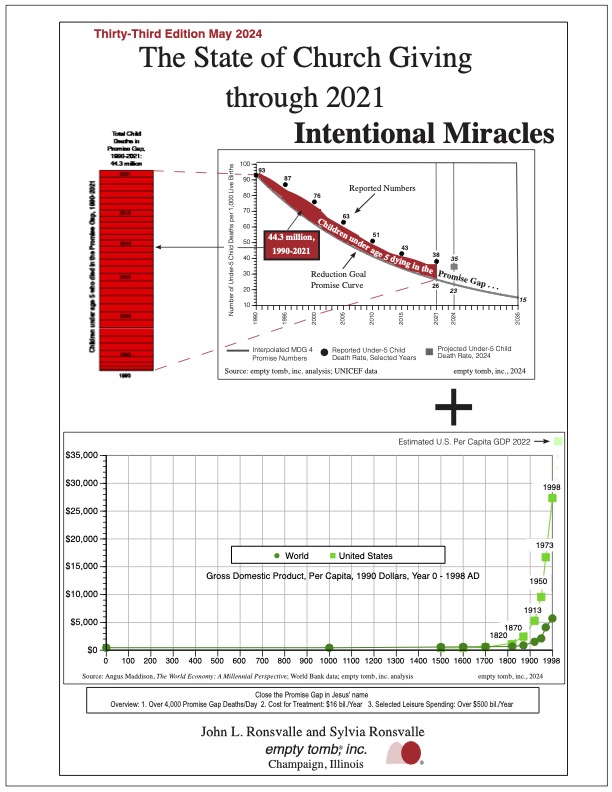
Intentional Miracles
33rd Edition, May 2024
Topics Include:
- An analysis of church giving patterns in the U.S. updated through 2021, based on aggregated congregational reports, including: 1968-2021 composite data set; 1921-2021 for 11 denominations; future trends.
- Denominational overseas missions income, 2003-2021.
- An updated review of giving potential of church members in the U.S., including for all church members, and for various church populations, as well as a discussion of the feasibility of increased giving through churches.
- An analysis of the U.S. Bureau of Labor Statistics, Consumer Expenditure Survey 2021, cash contributions to charitable causes.
- Chapter 8 considers the fact that church members can make this age of affluence an age of intentional miracles. Intentional miracles happen when someone decides to take an action, in Jesus’ name, with the strong possibility that the results of that action will have an intensely positive effect on a dire circumstance. How church people deciding to do more intentional miracles could affect the church, the youth, and society at large are explored. The potential for church people to reduce, in Jesus’ name, under-age-5 child deaths that are occurring around the world from treatable causes is demonstrated in chapter 8.
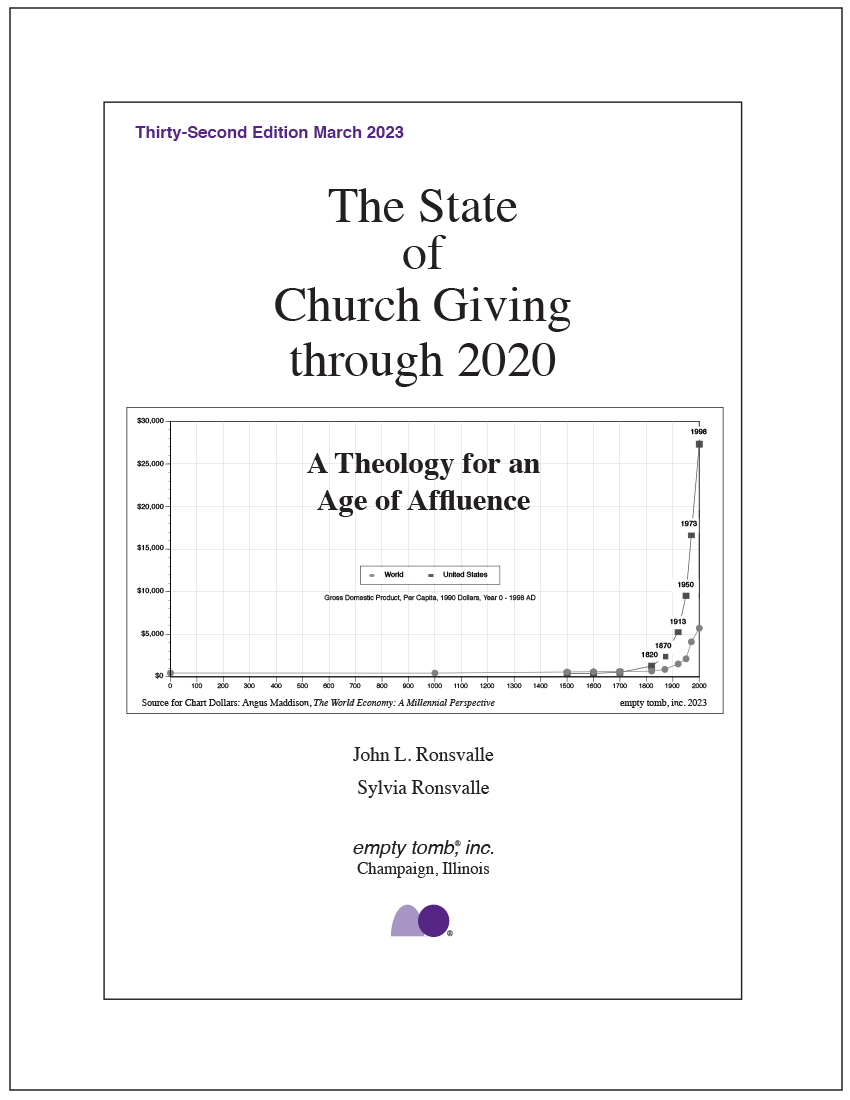
A Theology for an Age of Affluence
32nd Edition, March 2023
Topics include:
- 1968-2020 for a composite set of denominations: Giving as a percent of income was at the lowest point in 2020, the first year of the COVID pandemic. However, the downward trend began decades before.
- 1921-2020 for 11 denominations: Giving as a percent of income began to decline in 1961 and membership as a percent of population in 1962.
- Future trends: Data for the 1968-2020 period was projected for both church giving and membership.
- Denominational overseas missions income, 2003 through 2020: In 2020, congregations spent an average of 2¢ of each dollar received on global missions through their denominations. In contrast, for the 1916-1927 period, a group of denominations averaged 8¢ of each dollar on global missions.
- Potential Catholic giving in ten archdioceses: If church member giving increased to an average of 10% from current levels, these archdioceses would have had an additional $115 billion to spend in 2020.
- Analysis of U.S. Bureau of Labor Statistics Consumer Expenditure Survey (CE) 2020: Americans indicated that 58% of their 2020 donations went to “churches, religious organizations.”
- Chapter 8, A Theology for an Age of Affluence: The chapter considers three aspects of a theology for this age in which affluence is so widely spread in the U.S. The first section includes Figure 21, which charts the Angus Maddison analysis of per capita Gross Domestic Product in inflation-adjusted dollars from the Year 0 through 1998 AD. Ten points along this timeline indicate developments in the church, some having to do with attitudes toward money. The second section describes social developments in the U.S. that have accompanied the downward trends in church member giving and membership documented in the earlier chapters in the book. The third section explores verses and ideas of what a theology for an age of affluence might include.

Serve God with Money At-Scale or Serve Money
31st Edition, January 2022
Topics Include:
Chapters update church member giving and membership data in the U.S. through 2019, the year before the COVID pandemic set in. Analyses include:
- 1968-2019 data for a composite set of denominations: Per member giving was down in current dollars from 2018 to 2019.
- 1921-2019 data for 11 denominations: Once again, in the most recent year, per member giving as a percent of income was lower than in 1921 and in 1933, the depth of the Great Depression.
- Future trends: Membership and giving trends indicate continued decline in coming years.
- Denominational overseas ministries support through 2019: A broad set of churches continued to direct, on average, two cents of each dollar received on overseas missions.
- Cost-per-day for various church populations to address global needs: For example, 1.2 million child deaths could be prevented for 28¢ per day from church members in the U.S.
- Potential Catholic giving in ten archdioceses: Ten archdioceses in the U.S. would have had an additional $110 billion a year from parishioners in 2019, if giving had been at the classic 10% level.
- An analysis of the U.S. Bureau of Labor Statistics, Consumer Expenditure Survey 2019, and cash contributions to charitable causes: Giving to “church, religious organizations,” compared to gifts to “charities and other organizations” and “educational institutions,” received the most support whether data was analyzed by age bracket, income level, or region of the country.
- Chapter 8 is the special focus chapter. The subtitle, “Serve God with Money At-Scale or Serve Money,” sets the stage for the exploration of a topic that might give insight to the giving and membership trends presented in the first seven chapters. Citing data from Angus Maddison’s The World Economy: A Millennial Perspective, the chapter explores the new challenge facing church members in the U.S.: their relationship to money in an unprecedented sea of affluence. Historical church leaders are quoted on the role of money and the church. However, currently the church in the U.S. has not offered a positive agenda for this affluence. The consequences of that lack of vision are explored, with implications for the church and society as a whole. It is suggested that the church in the U.S. is in a unique position to lead its members to help reduce, in Jesus’ name, under-5 child deaths occurring from treatable causes, and thereby offer such a positive agenda. Lacking such an ambitious goal of serving God by using money at a scale that matches global need, it is posited that, in light of Jesus’ statement recorded in both Matthew 6:24 and Luke 16:13, the alternative is for the church to serve Money.

What If Jesus Comes Back in 2025?
30th edition, December 2020
Topics include:
Chapters update church member giving and membership data in the U.S., including:
- 1968-2018 data for a composite set of denominations.
- 1921-2017 data for 11 denominations.
- Future trends.
- Denominational overseas ministries support through 2018.
- Cost-per-day for various church populations to address global needs.
- Potential Catholic giving in ten archdioceses
- An analysis of the U.S. Bureau of Labor Statistics, Consumer Expenditure Survey 2018, and cash contributions to charitable causes.
- Chapter 8 is the special focus chapter, building on the information in the first seven chapters. The chapter presents an exercise using the question: What if Jesus returns in 2025? Acknowledging that no one knows the date of Jesus’ return, the fact that three groups have chosen 2025 as a goal date for their efforts provides a reason to focus on that year. A discussion of missio Dei as a framework for discipleship sets the stage for setting goals for: Bible translations; engaging unengaged unreached people groups; and closing, in Jesus’ name, the Promise Gap by reaching the target reduction goal for the global Under-5 Mortality Rate. A discussion follows of possible consequences that may develop if the church does not prepare, and alternatively, if the church does prepare, as if Jesus is coming back in 2025.
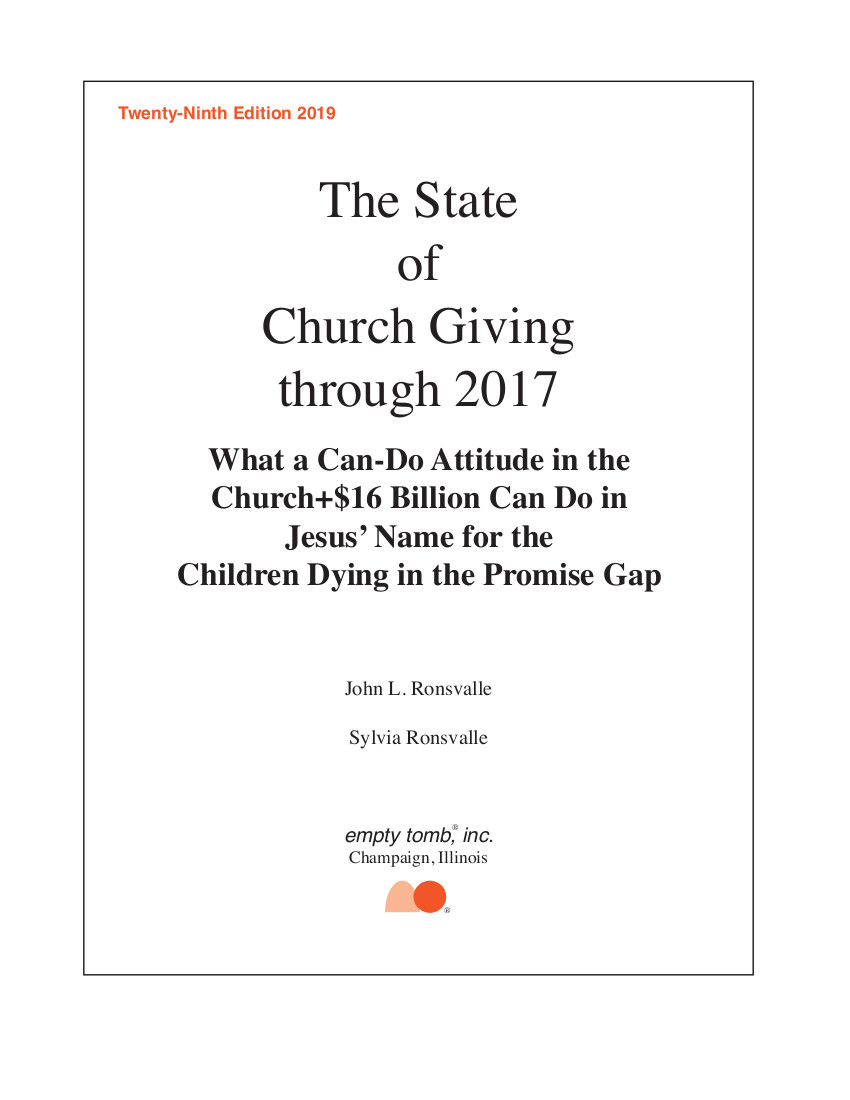
What a Can-Do Attitude in the Church+$16 Billion Can Do in Jesus’ Name for the Children Dying in the Promise Gap
29th Edition, October 2019
Topics Include:
Chapters update church member data in the U.S., including:
- 1968-2017 data for a composite set of denominations.
- 1921-2017 data for 11 denominations.
- Future trends.
- Denominational overseas ministries support through 2017.
- Cost-per-day for various church populations to address global needs.
- Potential Catholic giving in ten archdioceses.
- An analysis of the U.S. Bureau of Labor Statistics, Consumer Expenditure Survey 2017, and cash contributions to charitable causes.
- Chapter 8 is the special focus chapter. Downward trends in church giving and membership, explored in the earlier chapters, can be reversed. Ecclesiastes 3:11 says God has placed eternity in the human heart, but people don’t understand. The chapter explores directions people search for understanding, noting Hollywood seems to understand this need better than the church. The church has not but can provide a positive agenda for affluence: Closing, in Jesus’ name, the Promise Gap – – the difference between: 1) goals set to reduce the global Under-5 Child Mortality Rate (U5MR), and 2) the actual U5MR. Progress tables are included. With an average of 1 million children dying in the Promise Gap each year, the book states, “It’s time for the church to stop letting Hollywood have all the good lines.”
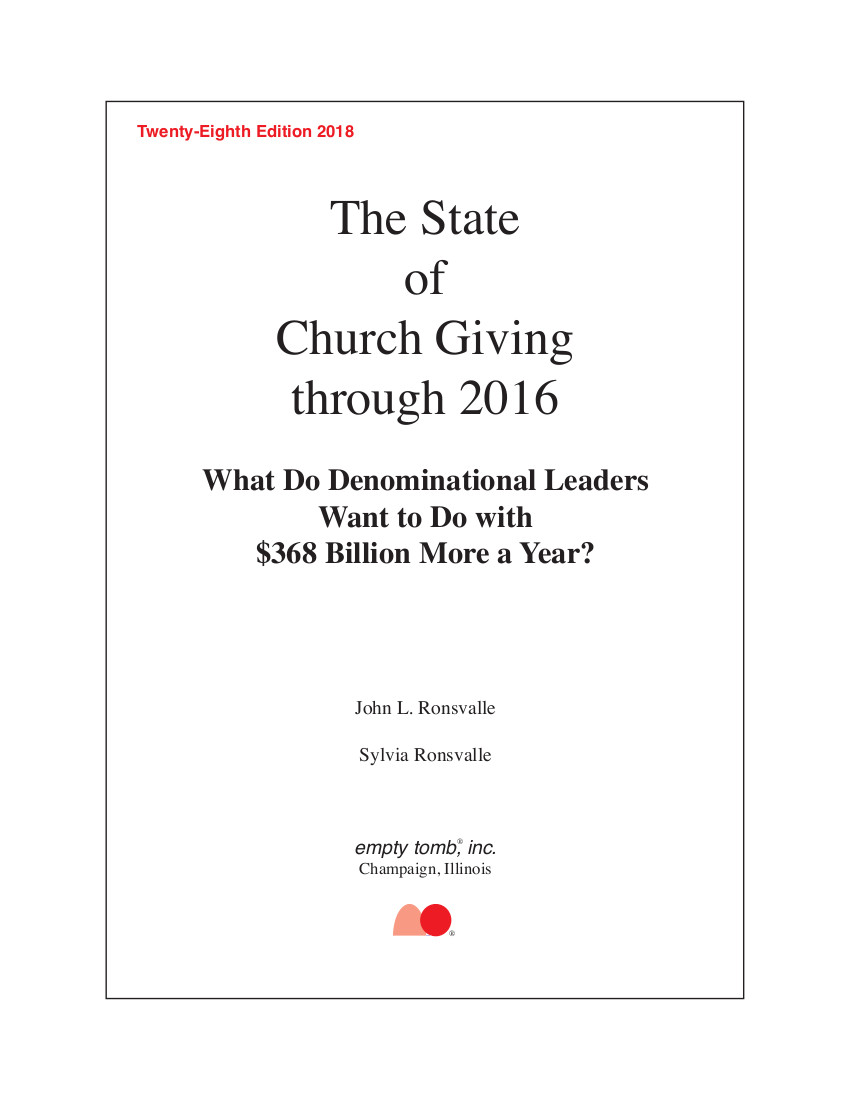
What Do Denominational Leaders Want to Do with $368 Billion More a Year?
28th Edition, September 2018
Topics Include:
Chapters update church member giving and membership data in the U.S.:
- 1968-2016 data for a composite set of denominations.
- 1921-2016 data for 11 denominations.
- Future trends.
- Denominational overseas ministries support through 2016.
- Cost-per-day for various church populations to address global needs.
- Other potential giving such as potential Catholic giving in ten archdioceses.
- U.S. Bureau of Labor Statistics Consumer Expenditure Survey 2016 data for charitable cash contributions, analyzed by age, region, and income levels, other estimates and media reports of philanthropy.
- Chapter 8 explores the data discussed in the earlier chapters from a broader context, centered on the key question that will help determine the future of the church in the U.S.: “What do denominational leaders want to do with $368 billion more a year?”
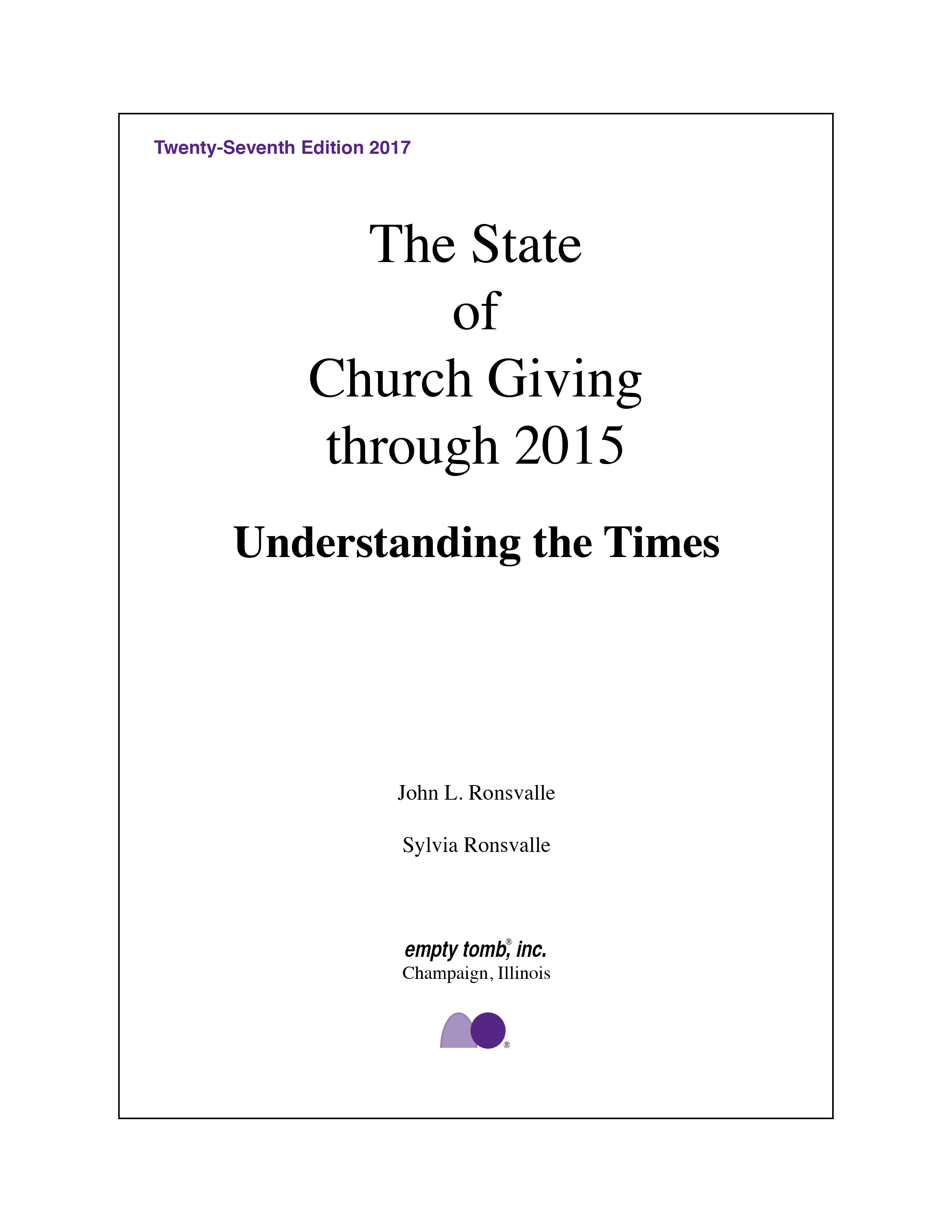
Understanding the Times
27th Edition, September 2017
Topics include:
Chapters updating church member giving and membership data in the U.S.:
- 1968-2015 for a composite set of Protestant denominations.
- 1921-2015 data for 11 Protestant denominations.
- Future trends based on past data in giving and membership.
- Denominational overseas ministries support, 2003-2015.
- Potential giving for various church populations, including nine Catholic archdioceses.
- U.S. Bureau of Labor Statistics Consumer Expenditure Survey 2015 data for charitable cash contributions, analyzed by age, region, and income levels.
- Chapter 8 provides a micro-summary of church history as background for a discussion of the challenges facing the church in the U.S. today. The challenge of affluence in present times has produced difficulties in the church and society as a whole. Church leaders will either be victims, bystanders, or will mobilize for a larger purpose. Tables provide data on 40 countries that were not on target as of 2015 to reduce the under-age-5 mortality rate in those countries to meet goals set by global leaders. The church in the U.S., it is suggested, can mobilize its giving and distribution abilities to meet this need and, as a result of loving a hurting world in Jesus’ name, engage the challenge of these times.

Speaking Truth to Power
26th Edition, September 2016
Topics Include:
Chapters updating church member giving and membership data in the U.S., including:
- 1968-2014 data for a composite set of denominations.
- 1921-2014 data for 11 denominations.
- Future trends.
- Denominational overseas ministries support through 2014.
- Cost-per-day for various church populations to address global needs.
- Other potential giving such as potential Catholic giving in nine archdioceses.
- U.S. Bureau of Labor Statistics Consumer Expenditure Survey 2014 data for charitable cash contributions, analyzed by age, region, and income levels.
- Chapter 8 explores the implications of the affluence that has flooded the U.S., especially since World War II. Its impact on society has been felt and not understood. The results, it is suggested, are evident in the church member giving and membership trends discussed in the first six chapters of the book. The proposed solution might be summarized as: repent and mobilize.
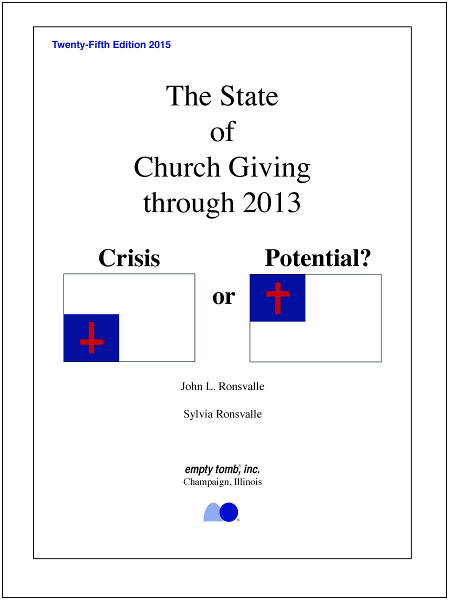
Crisis Or Potential?
25th Edition, October 2015
Topics Include:
- An analysis of church giving patterns in the U.S. updated through 2013, based on aggregated congregational reports.
- An original survey of denominational overseas missions income, 2003-2013.
- An updated review of giving potential of church members in the U.S., including all church members, and for various church populations.
- An analysis of the U.S. Bureau of Labor Statistics Consumer Expenditure Survey 2013, cash contributions to charitable causes.
- Although chapter 8 reviews the church member giving and membership data as well as various surveys that suggest a crisis facing the church in the U.S., the emphasis is on the potential for the church in the U.S. to impact global word and deed need in Jesus’ name. Such action, it is suggested, may help reverse the trends that point towards crisis.
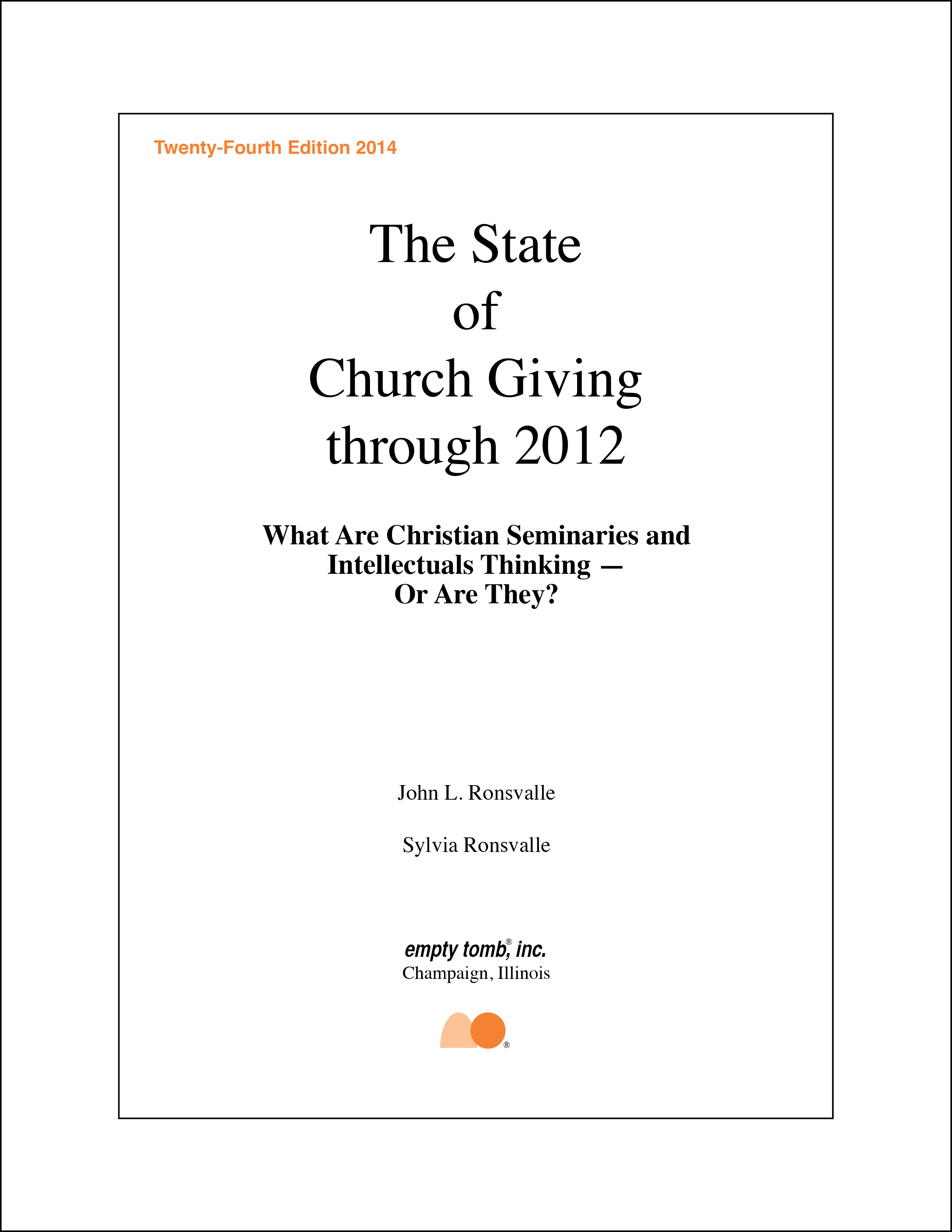
What Are Christian Seminaries and Intellectuals Thinking — Or Are They?
24th Edition, October 2014
Topics Include:
- An analysis of church giving patterns in the U.S. updated through 2012, based on aggregated congregational reports.
- An original survey of denominational overseas missions income, 2003-2012.
- An updated review of giving potential of church members in the U.S., including all church members, and for various church populations.
- An analysis of the U.S. Bureau of Labor Statistics Consumer Expenditure Survey 2012, cash contributions to charitable causes.
- A discussion of the need for a categorical shift in the way the church in the U.S. understands money. Five realities missed by Christian seminaries and intellectuals are explored: 1) The potential of the church; 2) Pastors are preaching to congregations filled with not the poor but the rich; 3) Money is a spiritual power; 4) Bigness and the illusion of powerlessness; 5) Seminaries and intellectuals must lead.
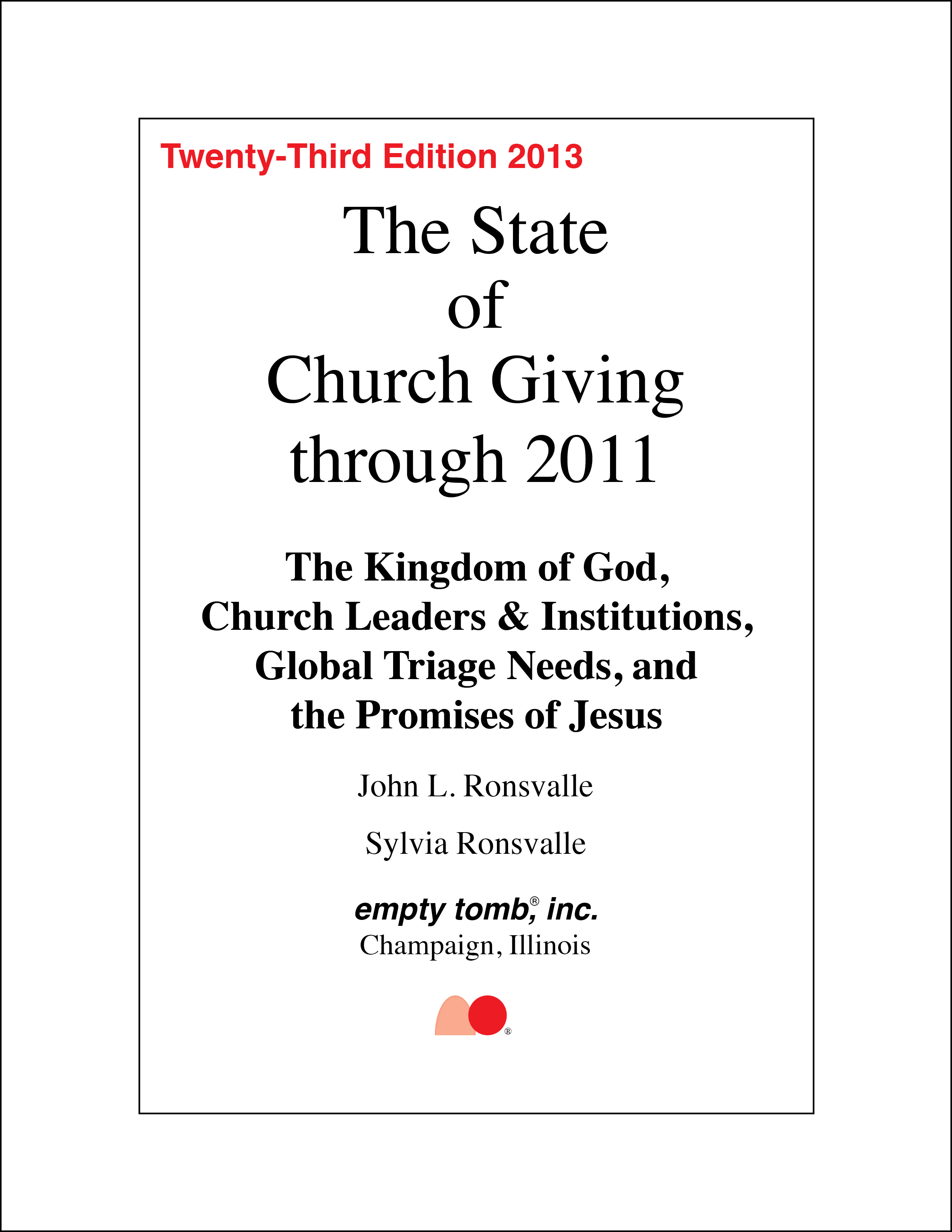
The Kingdom of God, Church Leaders & Institutions, Global Triage Needs, and the Promises of Jesus
23rd Edition, October 2013
Topics Include:
- An analysis of church giving patterns in the U.S. updated through 2011, based on aggregated congregational reports.
- An original survey of denominations’ overseas missions income, 2003-2011.
- An updated review of giving potential of church members in the U.S., including all church members, and for various church populations.
- An analysis of the U.S. Bureau of Labor Statistics, Consumer Expenditure Survey 2011, cash contributions to charitable causes.
- A discussion of the relationship of the kingdom of God, church leaders and institutions, global triage needs, and the promises of Jesus in light of the analyses in the first seven chapters of this edition in the series, in chapter 8.
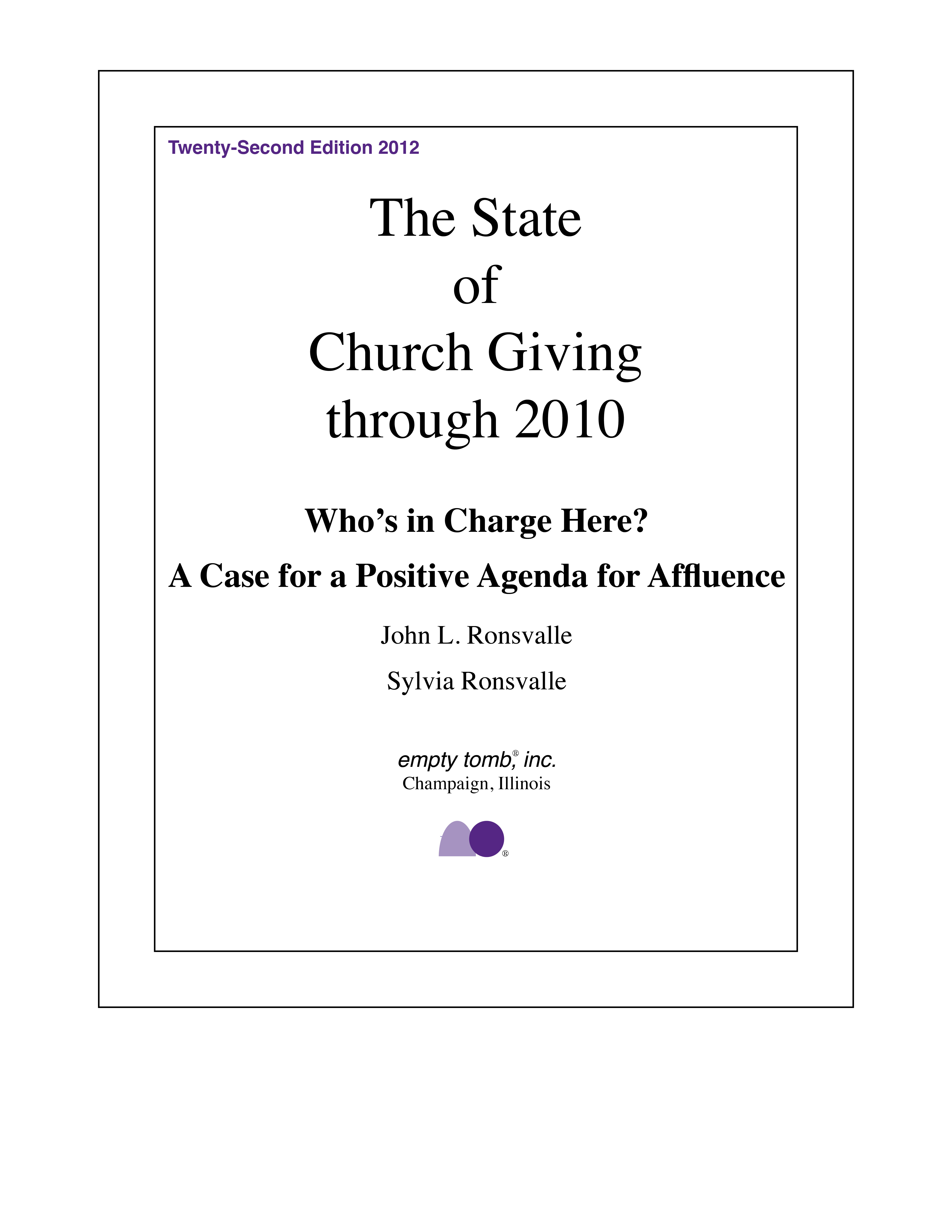
Who’s in Charge Here? A Case for a Positive Agenda for Affluence
22nd Edition, October 2012
Topics Include:
- An analysis of church giving patterns in the U.S. updated through 2010, based on aggregated congregational reports.
- An original survey of denominations’ overseas missions income, 2003–2010.
- An updated review of giving potential of church members in the U.S., including all church members, and for various church populations.
- An analysis of the U.S. Bureau of Labor Statistics Consumer Expenditure Survey 2010, cash contributions to charitable causes.
- A discussion of Matthew 6:24: the implications for church leaders and members of the choice between God and Money, and an exploration of a positive agenda for affluence.

Jesus Christ, the Church in the U.S., & the 16 No-Progress-in-Child Deaths Nations, 10 Being 84% Christian
21st Edition, September 2011
Topics include:
- An analysis of church giving patterns in the U.S. updated through 2009, based on aggregated congregational reports.
- An analysis of church member giving in recessions, 1968-2009 and 1921-1967.
- An original survey of denominations’ overseas missions income, 2003-2009.
- An updated review of giving potential of church members in the U.S., including all church members, and for various church populations.
- An analysis of the U.S. Bureau of Labor Statistics Consumer Expenditure Survey 2009, cash contributions to charitable causes.
- A discussion of Matthew 25:31-46, the parable of the sheep and the goats, in light of church member giving patterns in the U.S. in relationship to the 16 nations making no progress in decreasing child deaths among those under age 5, with 10 of those countries being 84% Christian.

Kudos to Wycliffe Bible Translators and World Vision for Global At-Scale Goals, But Will Denominations Resist Jesus Christ And Not Spend $1 to $26 Per Member to Reach The Unreached When Jesus Says, “You Feed Them?
20th Edition, September 2010
Topics include:
- An exploration of denominational leaders’ approach to Jesus priorities in the context of Jesus’ interaction with the first disciples in the miracle of the loaves and fish, as recounted in Mark 6:35-44.
- Church member giving in recession year 2008
- Church spending for denominational overseas ministries, 2003-2008
- Country-specific costs to address under-5 child deaths in 68 countries that account for 95% of these deaths, updated to 2008 data
- Updates of church member giving and membership, 1921-2008
- Comparison of Evangelical and Mainline Protestant giving, 1968-2008
- Church member giving and membership Trends based on 1968-2008 Data
- The potential of the church to impact global word and deed need through increased giving
- An analysis of the U.S. Bureau of Labor Statistics 2008 Consumer Expenditure Survey cash contributions
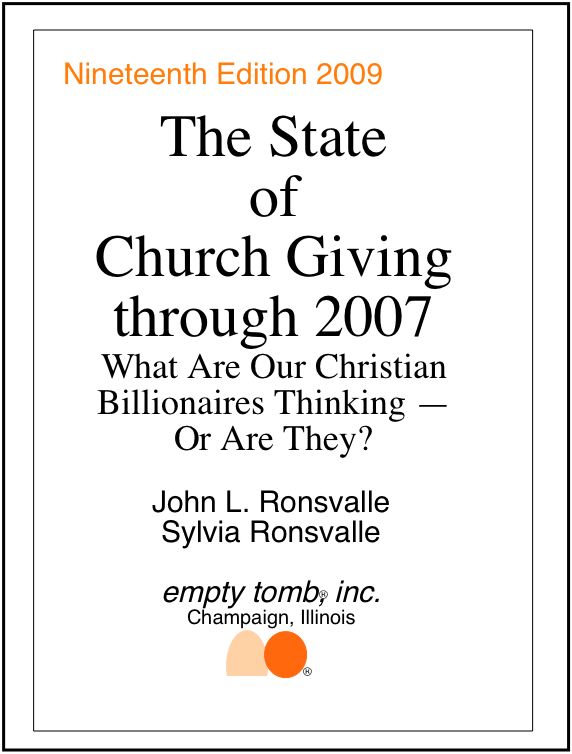
What Are Our Christian Billionaires Thinking — Or Are They?
19th Edition, October 2009
Topics include:
- An analysis of church giving patterns in the U.S. through 2007, based on aggregated congregational reports.
An analysis of the 2007 U.S. BLS Consumer Expenditure Survey Charitable giving data.
An original survey of 34 denominations’ overseas missions spending, 2003-2007. - Country-specific cost estimates to address eight causes of under-5 child deaths in 68 countries that account for 95% of these deaths.
- Discussion of one organization’s approach to global evangelization, and a case study of one denomination’s approach to its stated goal for engaging unreached people groups.
- A strategy for “wholesale” billionaire philanthropists (high-capacity donors) to mobilize “retail” billionaire philanthropists (supporters of multibillion dollar churches) to assist global and domestic need in Jesus’ name.

Global Triage, MDG 4, and Unreached People Groups
18th Edition, October 2008
Topics include:
- Church Giving and Membership Data and Trends Updated through 2006
- Global Triage for Word and Deed Need: A strategy of global triage is suggested as a solution for lukewarm giving patterns. Although church members in the U.S. could help both unreached people groups and the prevention of under-five child deaths for a few cents a day, church members and leaders are not mobilizing to do either. Setting priorities may help church members to be more faithful and help meet urgent needs at the same time.
- Why and How Much Americans Give: U.S. Bureau of Labor Statistics Consumer Expenditure Survey (CE) data for 2006 analyzed by U.S. Region, Age, and Income. Also a comparison of CE, Form 990, and the tax-return based Giving USA estimates of giving for 1989 through 2004, the latest data set year.
- The Potential of the Church: An empty tomb survey of 34 Protestant denominations’ Overseas Missions Income is extended through 2006, including cents per dollar by denomination. Also: Potential giving in nine Roman Catholic Archdioceses; cost per member for global evangelization and meeting various global needs for selected church populations; an update of potential giving at the 10% level.

Abolition of the Institutional Enslavement of Overseas Missions
17th Edition, October 2007
Topics include:
- An analysis of church giving patterns in the U.S. through 2005, based on aggregated congregational reports.
- An analysis of the 2005 U.S. BLS Consumer Expenditure Survey Charitable giving data.
- An original survey of the 34 denominations’ overseas missions spending, 2003-2005.
- A discussion of denominational structures in relationship to the support of congregational overseas missions.
- An exploration of the potential for church members in the U.S. to impact global and domestic need through increased giving through their congregations.
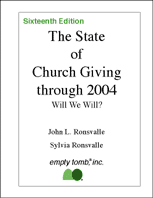
Will We Will?
16th Edition, October 2006
Topics include:
- Update on Church Member Giving and Membership Trends through 2004
- New Survey of 2004 Overseas Missions Support in 34 Denominations
- Calculated Per Member Cost Per Day to Address Global Evangelization and Physical Need for Various Church Populations
- Roman Catholic Potential Giving in Eight Archdioceses
- A Proposal from the National Council of the Churches of Christ in the U.S.A. to Increase Giving to 0.7%, Applied to The United Methodist Church
- Consideration of the Effects of the Unified Budget in One Denomination, the Southern Baptist Convention
- Why and How Much Americans Give: This chapter includes a comparison of the U.S. Bureau of Labor Statistics Consumer Expenditure Survey, the Internal Revenue Service Forms series, and the IRS charitable deductions-based Giving USA estimates for total contributions in the U.S. The chapter also includes an analysis of the Consumer Expenditure Survey charitable giving data for 2004 by Age, Region of Residence in the U.S., and Income Levels.
- Will We Will?: This chapter considers: the role of traditional and meta-denominations; the process of disintermediation between denominations and congregations, and the possibility of reintermediation; the practice by denominational leaders of cathartic drama rather than practical mobilization for global needs; and the institutional enslavement of overseas missions as a consequence of the unified budget.

The State of Church Giving through 2003
15th Edition, October 2005
Topics include:
- The Potential of the Church: An empty tomb survey of 28 Protestant denominations’ Overseas Missions Income for 2003 (including 146,000 congregations). A comparison of Overseas Missions Income in the 1920s and 2003. An update of potential giving at the 10% level, and the potential of the church to impact global need in Jesus’ name.
- The relationship between membership growth and Overseas Missions Income.
- Church Giving and Membership Data Updated through 2003: Updated and confirmed giving data from 1968-2003. Analysis of evangelicals and mainline Protestant giving trends, 1968-2003 trends in membership and giving patterns, and giving and membership from 1921-2003.
- Giving Patterns and the Church’s Priorities: A review of the Yearbook of American and Canadian Churches series, 1916-1982 editions, to explore church priorities. A discussion of dynamics defining current church priorities, especially regarding the prime directive of the Great Commission.
- Measurement of Philanthropy: A review of national media reports on national philanthropy data. An analysis of U.S. Bureau of Labor Statistics, Consumer Expenditure Survey charitable giving data.

The State of Church Giving through 2002
14th Edition, October 2004
Chapter Highlights:
Contains a detailed 20-year update of empty tomb’s Yoking Map® and the Fourth Annual Measurement of Philanthropy Report Card. Also, a discussion of why church members do not give more, exploring the practice of idolatry in the context of the Apostle Paul equating greed with idolatry (Eph. 5:5 and Col. 3:5).
- Church Member Giving, 1968-2002
- Church Member Giving for 41 Denominations, 2001 to 2002
- Church Member Giving in Denominations Defined by Organizational Affiliation, 1968, 1985, and 2002
- Church Member Giving and Membership in Eleven Denominations, 1921-2002
- Church Member Giving and Membership Trends Based on 1968-2002 Data
- The Potential of the Church
- Measuring Charitable Giving in the United States
- Helping Church Members Care Effectively: Yoking Map® Twenty-Year Update

Behind the Stained Glass Windows: Money Dynamics in the Church (Baker Books, 1996)
What are the dynamics at the congregation level that contribute to declining church member giving? This book reports on a three-year study by empty tomb, inc. The project included encounters with hundreds of local congregations, a nationally-distributed survey as well as interviews with over 40 national church leaders.
Edit This Publication
At Ease: Discussing Money and Values in Small Groups
(Alban Institute, 1998)
Well known for their innovative writings on churches and money, the Ronsvalles of empty tomb, inc. team up with U. Milo Kaufmann to present their newest work in this field: a method for making people comfortable about the difficult issues of linking money and values. The method is based on congregational small-group discussions that create support and trust to help individuals identify their fears and worries, as well as their attitudes on stewardship and support of the church. A series of questions leads participants by steps to new and increasingly probing conversations about these issues.
Edit This Publication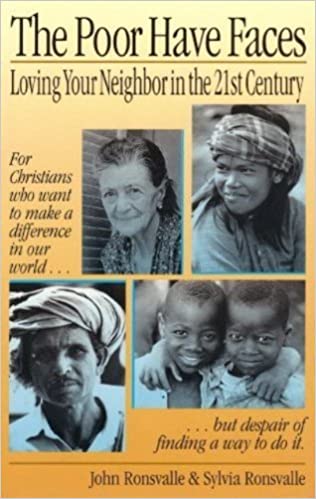
The Poor Have Faces: Loving Your Neighbor in the 21st Century
(Baker Book House, 1992)
Building upon their church giving research, the Ronsvalles reflect on the potential of the church to impact global and domestic needs. Sharing experiences from their local ministry outreach and global interactions, they suggest that although people truly want to help their neighbors, people often feel overwhelmed by the world’s extensive problems. In response, this book realistically looks at the church in America’s unique resources, challenges Christians to adopt a personal, biblical view of stewardship, and lays out a viable plan of action to significantly reduce desperate world and domestic conditions and spread the gospel of Jesus Christ.
Edit This Publication